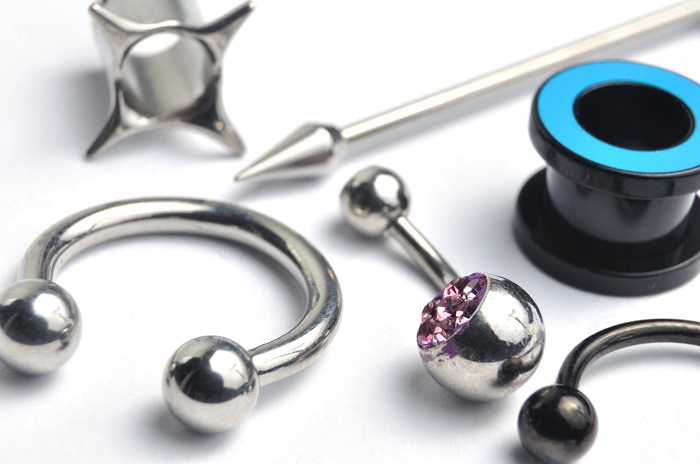
Unhealthy Practices
- Bulimia
- Grills, Grillz and Fronts
- Kicking the nicotine habit
- Meth Mouth
- Oral Piercing and Health
- Tobacco Use Cessation
- Tongue Piercing & Its Dental Effects
Share This Page
Not too long ago, teens wanted to avoid the moniker "metal mouth," but the oral piercing trend seems to have overshadowed that social fear. Now piercing the tongue, lip or cheeks is a fairly popular form of self-expression.
People interested in this trend, however, should be aware that it is not without health risks.
PROCEDURE-RELATED RISKS
Infection. Infection is a possibility with any opening in skin or oral tissues. Given that the mouth is teeming with bacteria, oral piercing carries a high potential for infection at the site of the piercing. Handling the jewelry once it has been placed also increases the chances of developing an infection.
Prolonged bleeding. Damage to the tongue’s blood vessels can cause serious blood loss.
Swelling and possible nerve damage. Swelling is a common symptom experienced after oral piercing. Unlike an earlobe that is pierced, the tongue is in constant motion, which can slow and complicate the healing process. There have been some reports of swelling subsequent to tongue piercing that has been serious enough to block the airway.
Bloodborne disease transmission. Oral piercing also has been identified by the National Institutes of Health as a possible factor in transmission of hepatitis B, C, D and G.
Although no cases of tetanus or tuberculosis transmission have been reported with regard to oral piercing, both have been documented in association with ear piercing.
Endocarditis. In addition, oral piercing carries a potential risk of endocarditis, a serious inflammation of the heart valves or tissues. The wound created during oral piercing provides an opportunity for oral bacteria to enter the bloodstream, where they can travel to the heart. This presents a risk for people who have cardiac abnormalities, on which the bacteria can colonize.
JEWELRY-RELATED COMPLICATIONS
Injury to the gums. Not only can the metal jewelry injure the gums, but also, if it is placed so that it makes constant contact with the gums, it can cause the soft tissues to recede.
Damage to the teeth. Contact with the jewelry can chip or crack teeth. Likewise, teeth that have restorations can be damaged if jewelry strikes them.
Interference with normal oral function. Oral jewelry can stimulate excessive saliva production, can impede the ability to pronounce words clearly, and may cause problems with chewing and swallowing food.
Furthermore, metal alloys used in the manufacturing of oral jewelry can potentially sensitize susceptible people, resulting in allergic contact dermatitis.
Interference with oral health evaluation. Jewelry in the mouth can block the transmission of X-rays. Clear radiographs, what you know as "X-rays," are essential to a complete oral health evaluation. Jewelry can prevent a radiograph from revealing abnormalities like cysts, abscesses or tumors.
Aspiration. There is always a possibility that the jewelry can come loose. As with any loose object in the mouth, unfastened jewelry becomes a choking hazard. The jewelry also could be ingested, which could result in injury to the digestive tract.
People interested in this trend, however, should be aware that it is not without health risks.
PROCEDURE-RELATED RISKS
Infection. Infection is a possibility with any opening in skin or oral tissues. Given that the mouth is teeming with bacteria, oral piercing carries a high potential for infection at the site of the piercing. Handling the jewelry once it has been placed also increases the chances of developing an infection.
Prolonged bleeding. Damage to the tongue’s blood vessels can cause serious blood loss.
Swelling and possible nerve damage. Swelling is a common symptom experienced after oral piercing. Unlike an earlobe that is pierced, the tongue is in constant motion, which can slow and complicate the healing process. There have been some reports of swelling subsequent to tongue piercing that has been serious enough to block the airway.
Bloodborne disease transmission. Oral piercing also has been identified by the National Institutes of Health as a possible factor in transmission of hepatitis B, C, D and G.
Although no cases of tetanus or tuberculosis transmission have been reported with regard to oral piercing, both have been documented in association with ear piercing.
Endocarditis. In addition, oral piercing carries a potential risk of endocarditis, a serious inflammation of the heart valves or tissues. The wound created during oral piercing provides an opportunity for oral bacteria to enter the bloodstream, where they can travel to the heart. This presents a risk for people who have cardiac abnormalities, on which the bacteria can colonize.
JEWELRY-RELATED COMPLICATIONS
Injury to the gums. Not only can the metal jewelry injure the gums, but also, if it is placed so that it makes constant contact with the gums, it can cause the soft tissues to recede.
Damage to the teeth. Contact with the jewelry can chip or crack teeth. Likewise, teeth that have restorations can be damaged if jewelry strikes them.
Interference with normal oral function. Oral jewelry can stimulate excessive saliva production, can impede the ability to pronounce words clearly, and may cause problems with chewing and swallowing food.
Furthermore, metal alloys used in the manufacturing of oral jewelry can potentially sensitize susceptible people, resulting in allergic contact dermatitis.
Interference with oral health evaluation. Jewelry in the mouth can block the transmission of X-rays. Clear radiographs, what you know as "X-rays," are essential to a complete oral health evaluation. Jewelry can prevent a radiograph from revealing abnormalities like cysts, abscesses or tumors.
Aspiration. There is always a possibility that the jewelry can come loose. As with any loose object in the mouth, unfastened jewelry becomes a choking hazard. The jewelry also could be ingested, which could result in injury to the digestive tract.


